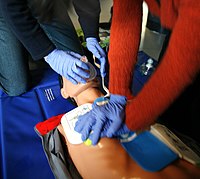
Photo from wikipedia
Previous analyses from EU-CaRE study have shown that elderly cardiac patients with basic education have a greater burden of cardiovascular risk factors and a lower exercise capacity at baseline of… Click to show full abstract
Previous analyses from EU-CaRE study have shown that elderly cardiac patients with basic education have a greater burden of cardiovascular risk factors and a lower exercise capacity at baseline of cardiac rehabilitation (CR). We hypothesize that participation in CR will diminish this socioeconomic gap. To describe if educational level predicts the benefits of CR in an elderly population in Europe. The observational EU-CaRE study is a prospective study with eight participating CR centers in seven countries (Denmark, France, Germany, the Netherlands, Italy, Spain and Switzerland). Consecutive patients age 65 or older with coronary heart disease or valve surgery participating in CR were included. Data were obtained at baseline (T0) and at the end of CR (T1) and include risk factors for cardiovascular disease, clinical and psychological assessment, medical treatment and exercise capacity. Patients were divided into basic, intermediate and higher educational levels. We compared changes from T0-T1 by multiple regression models. A total of 1621 (99% of included) patients were eligible for follow-up analyses. At baseline patients with basic education had more diabetes, higher BMI, lower exercise capacity (VO2 peak) and higher scores for depression (GAD) and anxiety (PHQ-9). At T1 they had improved significantly less on these parameters. The results were not affected by adjustment for gender, age, country and baseline value of the variable. Use of evidence-based medication did not differ by level of education. Difference between T0 and T1 Factor High Intermediate Basic p-value* N total 1621 N=386 N=775 N=460 BMI, mean (SD) −0.16 (0.71) −0.08 (0.82) −0.26 (0.95) 0.794 LDL (mmol/L), mean (SD) −0.07 (0.63) −0.11 (0.62) −0.04 (0.58) 0.978 HbA1c (mmol/mol), mean (SD) 0.23 (3.70) 0.52 (4.39) 0.04 (5.79) 0.021 GAD score, mean (SD) −0.92 (2.72) −0.76 (3.07) −0.13 (3.47) 0.003 PHQ-9 score, mean (SD) −1.45 (3.21) −1.16 (3.36) −0.93 (4.49) <0.001 Diet score, mean (SD) 0.57 (1.72) 0.63 (1.90) 0.23 (1.81) 0.003 VO2 peak (ml/kg/min), mean (SD) 2.47 (2.90) 1.95 (2.78) 1.75 (2.56) 0.016 *Adjusted for gender, age, country and baseline value. Difference in VO2peak, GAD and PHQ score In this large European study with high-quality data from 7 CR centers we found an increased gap disfavoring the lower educated elderly patients participating in CR. These results indicate that “one-size cardiac rehabilitation” does not fit all and indicate that a more personalized CR with attention to the different needs of some patient groups is appropriate. Horizon2020
Journal Title: European Heart Journal
Year Published: 2019
Link to full text (if available)
Share on Social Media: Sign Up to like & get
recommendations!